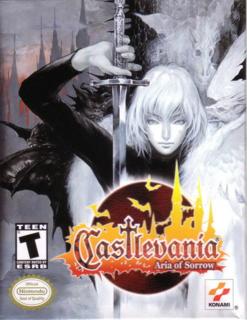Yet another Castlevania quest to stop Dracula results in yet another very fun game.
With the setting 2035, the time of Japan's first eclipse of the 21st century, young Soma Cruz finds himself warped away to a mysterious castle. Learning that he's actually inside the eclipse and that the castle is Dracula's, thought banished away in 1999, he finds himself with a quest to undertake, and powers he never knew he had. The previous game's elemental spell book system of magic is replaced with the tactical soul system, which allows Soma to absorb souls of defeated enemies. Some grant an attack power from the monster, some a passive ability like a skill upgrade, and some an activatable non-combat or defensive ability like longer jumping or a protective shield--and you'll be able to equip one each of those three soul types at any one time. They're joined by a fourth soul type that grant permenant abilities, generally needed to get to certain areas of the castle, and generally guarded by bosses. Along the way he meets others with information on the castle, and even an old friend, to Castlevania fans, at least. The time setting actually turns out to be irrelevant--there's no ray guns, mostly old-time weapons like swords, spears, and hammers, with a handgun being the most modern technology. As always, the castle is filled with numerous hidden areas and cryptic clues to ensure that only the most intrepid and clever will get the best ending and see all the castle on their own merits, and that's what makes it all the more fun.
The soul system is the game's shining star--it gives you dozens of possible combinations, and even though you'll likely settle into your favorites with little deviation (especially with attack souls), knowing the options are there is a comfort. It's easy to see why they kept the system when they made the first DS Castlevania game. The story is simpler, and makes a bit more sense, than the previous game, though stays true to Castlevania traditions. It's also more challenging than Harmony of Dissonance--the combination of more monsters that come out in never-ending waves and a limit to the number of healing potions you can carry means you get placed in jeopardy a bit more often. Luckily, save rooms (which also fully heal you) are in plentiful supply, so you have to redo a ton of gaming if you use them wisely. The shopkeeper is also better, as unlike the previous game, he'll buy weapons and armor you no longer need, though the 'Engrish' use of the word "keeping" to indicate how many of an item you have in your possession persists.
The game's brevity is a bit of a let-down, as even with giving some minimal attention to where secrets might be, it's no longer than a 10-hour game (less for better players), though a 'Hard+' mode after initial completion is there for those who want to replay with a bit more challenge. Again, backtracking is an issue, and even though the halls are filled with more re-spawning monsters, eventually Soma's power reaches the point that they're more a time-consuming agitation than an actual threat. There are warp rooms spread around the castle, but you often have to backtrack to one, and then away from one to get where a new power will let you access. Water navigation is also something of a hassle, unavoidable as water is used to block off some areas until powers like walking on water or being able to sink/walk in water become available. At times you'll have to switch back and forth between the souls that grant those powers a few times in succession to get from point A to B, requiring going to the menu every few seconds to swap souls.
The game flows well from one area to the next, and all powers are acitivated crisply and easily. The graphics look as nice as they always have, though many graphics are recycled from Harmony of Dissonance, including creature models that have just been tinged a new color to represent a hardier version of a monster. The soundtrack is better than the predecessor, giving the appropriate Gothic feel to the experience. While the game is a very quick play, with nothing overly new to do once it's done, it's so fun while it lasts that it's not a major concern. Konami has simply once again done what they've done time and time again--create a Castlevania game that's accessible to anyone, but still feels comfortingly familiar and purchaseworthy to fans of the series.

